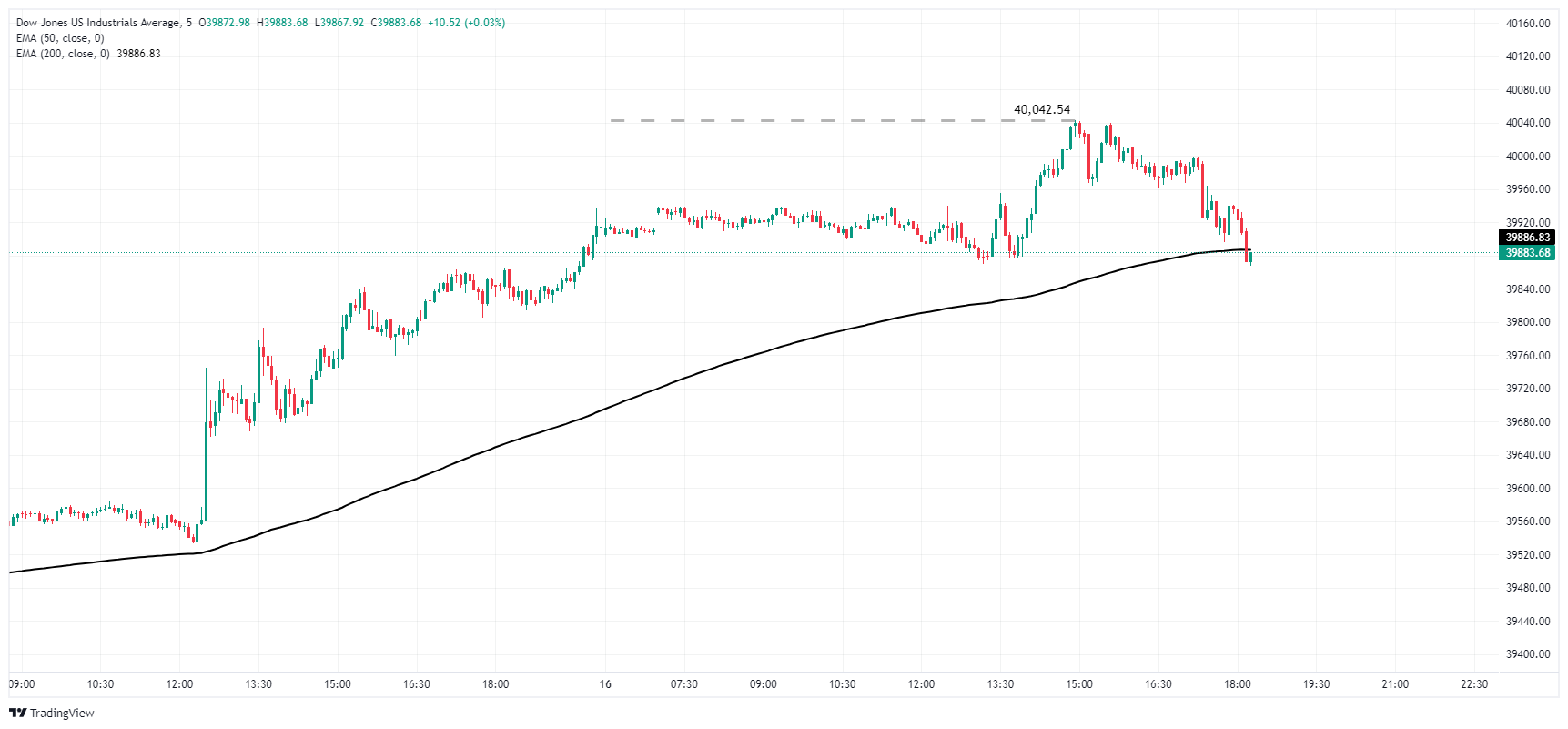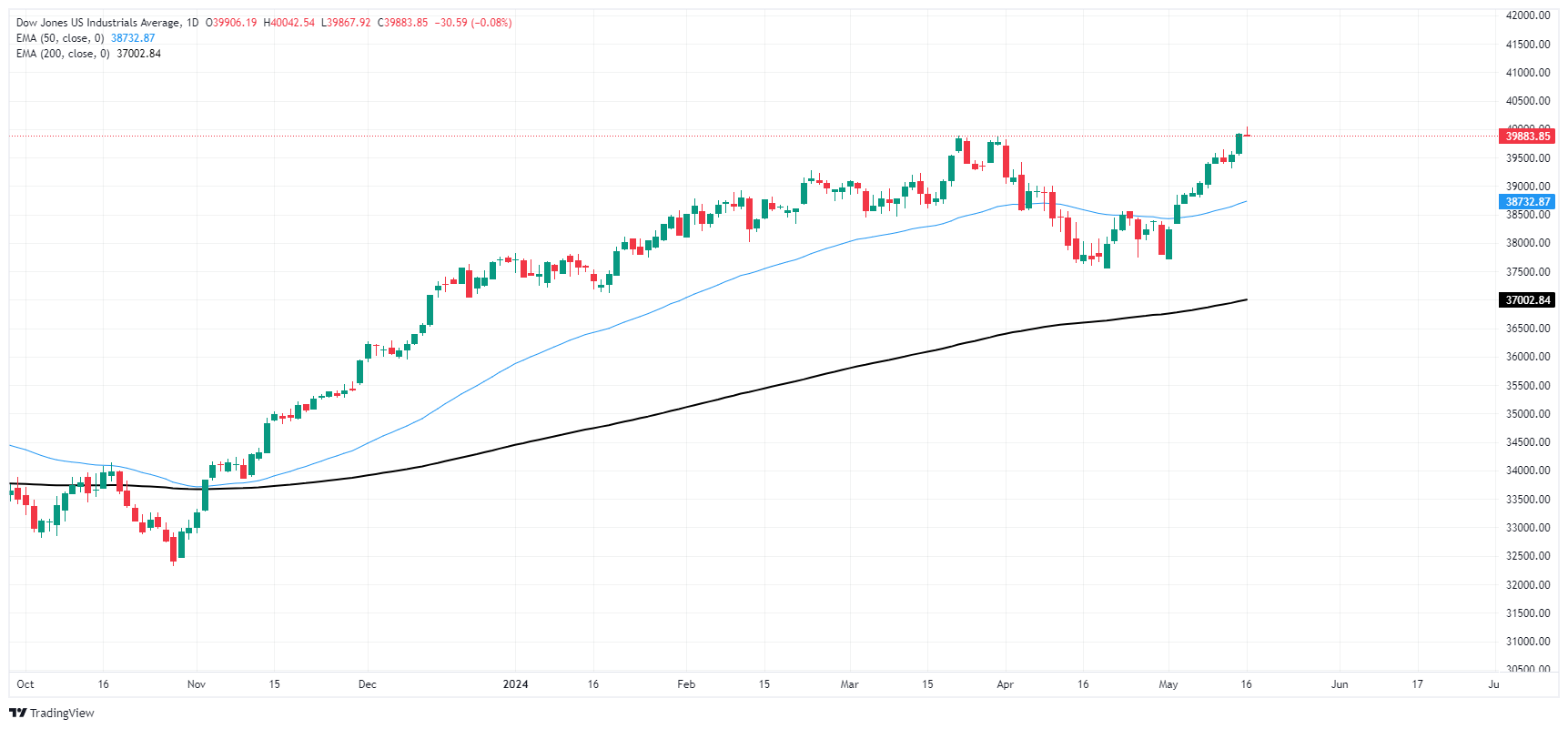- Dow Jones hits a new all-time high on Thursday.
- Data calendar remains sparse, Fed words dominate news cycle.
- Despite record bids, Dow Jones gains remain slim.
The Industrial Average Dow Jones (DJIA) surpassed the important 40,000 price level on Thursday as shares rise amid a sparse data calendar. Stock indices hit new record highs after a mid-week US inflation report showed price growth continues to cool, raising fresh hopes of rate cuts by the Federal Reserve (Fed).
Despite headline inflation numbers showing a slowdown, Fed officials continue to manage expectations cautiously, highlighting the central bank's neutral stance until data further confirms that current policies are working to ease inflation. Investors are wavering as the Fed's words weigh on risk sentiment, however, rates markets are still pricing the odds of at least a quarter-point cut by the Fed in September at 70% according to the CME FedWatch tool.
Dow Jones News
Nearly a third of the Dow's constituent stocks are in the red on Thursday, capping overall gains for the major stock index. Caterpillar Inc. (CAT) is down -2.7%, losing almost ten points and falling to $350.35 per share. Despite the short-term declines, Caterpillar shares have been booming, doubling in value since the Dow Jones first crossed 30,000 in late 2022.
On the bright side, Walmart Inc. (WMT) soared nearly 7% on Thursday, gaining 4.12 points to trade near $64.00 per share. Walmart soared after beating quarterly profit and revenue forecasts as the retail giant challenges Amazon as an online retailer after Walmart's e-commerce sales grew 22% in the US.
Dow Jones Technical Outlook
The Dow Jones broke north of 40,000.00 on Thursday, hitting a new all-time high of 40,042.54 before investors pulled back midway through the US market session. The DJIA has retreated to the 39,900.00 region, but buying pressure remains near the surface.
Despite the hesitation following Thursday's peak, the DJIA remains firmly bullish, having closed higher in all but one of the last ten consecutive trading sessions. The Dow Jones is up 6.65% from low to high in 2024, and is trading well above the 200-day Exponential Moving Average (EMA) at 37,020.70.
Dow Jones Five Minute Chart
Dow Jones Daily Chart
The Dow Jones FAQs
The Dow Jones Industrial Average, one of the world's oldest stock indices, is made up of the 30 most traded securities in the United States. The index is weighted by price rather than capitalization. It is calculated by adding the prices of the securities that comprise it and dividing them by a factor, currently 0.152. The index was founded by Charles Dow, also founder of the Wall Street Journal. In recent years it has been criticized for not being sufficiently representative, since it only follows 30 companies, unlike broader indices such as the S& P 500.
There are many factors that drive the Dow Jones Industrial Average (DJIA). The main one is the aggregate performance of its component companies, revealed in quarterly corporate earnings reports. US and global macroeconomic data also contribute, influencing investor sentiment. The level of interest rates, set by the Federal Reserve (Fed), also influences the DJIA, as it affects the cost of credit, on which many companies largely depend. Therefore, inflation can be a determining factor, as well as other parameters that influence the Federal Reserve's decisions.
The Dow Theory is a method for identifying the main trend of the stock market developed by Charles Dow. A key step is to compare the direction of the Dow Jones Industrial Average (DJIA) and the Dow Jones Transportation Average (DJTA) and only follow trends where both are moving in the same direction. Volume is a confirmation criterion. The theory uses elements of maximum and minimum analysis. The Dow theory proposes three phases of the trend: accumulation, when the smart money begins to buy or sell; public participation, when the general public joins the trend; and distribution, when the smart money abandons the trend.
There are several ways to trade the DJIA. One of them is to use ETFs that allow investors to trade the DJIA as a single security, instead of having to buy shares of the 30 companies that comprise it. A notable example is the SPDR Dow Jones Industrial Average ETF (DIA). Futures contracts on the DJIA allow traders to speculate on the future value of the index, and options provide the right, but not the obligation, to buy or sell the index at a predetermined price in the future. Mutual funds allow investors to purchase a portion of a diversified portfolio of DJIA securities, providing exposure to the global index.
Source: Fx Street
I am Joshua Winder, a senior-level journalist and editor at World Stock Market. I specialize in covering news related to the stock market and economic trends. With more than 8 years of experience in this field, I have become an expert in financial reporting.







